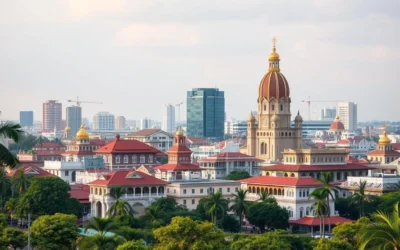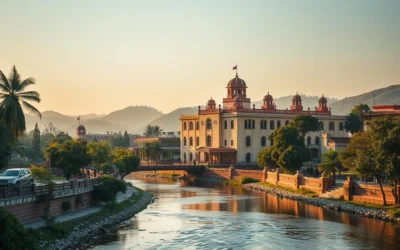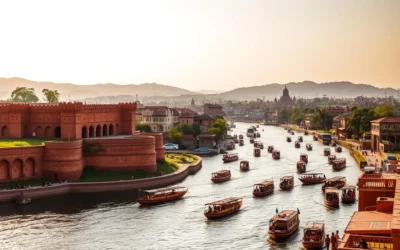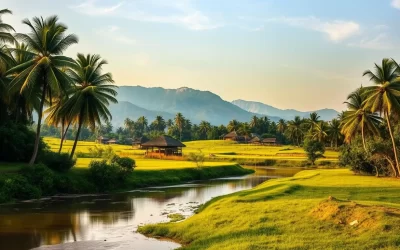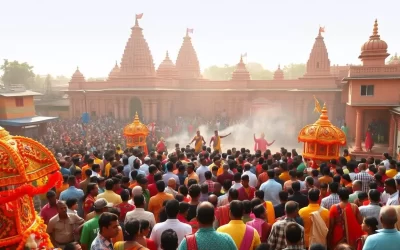You’re about to explore the rich linguistic landscape of Odisha, where multiple languages coexist. The predominant language here is Odia, which is not only the official language but also recognized as a classical language of India since 2014.
Native speakers of Odia make up a significant portion of the population, and it’s also widely spoken in neighboring states. As you delve deeper, you’ll discover the historical evolution of the Odia language and its various dialects across different regions. This will give you insights into the language family and the cultural significance of Odia in Indian languages.
By understanding the geographical distribution and linguistic diversity, you’ll gain a deeper appreciation for the languages that shape the identity of this region.
The Linguistic Landscape of Odisha
You’ll discover that Odisha’s language landscape is influenced by its location, history, and interactions with neighboring regions. The state’s unique cultural and geographic characteristics have shaped its linguistic profile.
Geographic and Demographic Context
Odisha, located in northeastern India, covers an area of 155,707 square kilometers with diverse topography ranging from coastal plains to highlands. This varied geography has contributed to the development of distinct language varieties across different regions.
Demographically, Odisha is home to approximately 45 million people, with Odia speakers constituting about 82% of the state’s population according to recent census data. The population distribution and density have played a significant role in shaping the linguistic landscape.
Overview of Language Distribution in Odisha
The language distribution in Odisha follows geographical patterns, with standard Odia (also known as Mughalbandi) predominantly spoken in the coastal districts including Cuttack, Puri, and Bhubaneswar. Other dialects such as Sambalpuri in western Odisha, Ganjami Odia in southern regions, and Baleswari Odia in northern areas are also prevalent, each with distinctive vocabulary and pronunciation patterns.
- The state hosts numerous tribal languages belonging to Austroasiatic, Dravidian, and Indo-Aryan language families, creating a rich tapestry of linguistic diversity.
- Urbanization and migration patterns have influenced language distribution, with cities showing greater linguistic diversity compared to rural areas.
- According to the 2011 census, there are 37.52 million Odia speakers in India, making up 3.1% of the country’s population.
Understanding the linguistic landscape of Odisha provides insights into the language and cultural heritage of the state and its regions.
Odia: The Official Language of Odisha
As you explore the linguistic landscape of Odisha, you’ll discover the significance of Odia as the official language. Odia is one of the twenty-two official languages of India and holds a prominent position in the state.
Official Status and Recognition
Odia gained its official status in Odisha following the linguistic reorganization of states in 1956. The language is recognized under the Eighth Schedule of the Indian Constitution, making it one of the 22 scheduled languages with special constitutional protections and development support. The Official Languages Act influences the use of Odia in government administration, education, and public communications throughout the state.
You’ll understand how Odia serves as the primary medium for state legislative proceedings, judicial matters, and administrative documentation in Odisha. This official language plays a crucial role in the functioning of the state’s government and public services.
- Odia is recognized under the Eighth Schedule of the Indian Constitution.
- The Official Languages Act supports the use of Odia in government administration.
- Odia is used in state legislative proceedings and judicial matters.
Percentage of Speakers in Odisha
According to the 2011 census data, approximately 82% of Odisha’s population speaks Odia as their first language, amounting to over 35 million speakers within the state. The percentage of Odia speakers varies significantly across different districts, with coastal regions showing higher concentrations.
You’ll discover that the language also enjoys substantial speaker populations in neighboring states like Jharkhand, West Bengal, Chhattisgarh, and Andhra Pradesh, bringing the total number of Odia speakers in India to around 38 million.
The spread and standardization of Odia have been influenced by urbanization and education patterns across different demographic groups within the state.
Historical Evolution of Odia Language
You’ll uncover the intriguing journey of the Odia language, from its ancient roots to its modern form. The history of Odia is a testament to its resilience and adaptability over the centuries.
Origins and Early Development
The Odia language has its roots in Eastern Magadhi Prakrit, an ancient Indo-Aryan language spoken in eastern India over 1,500 years ago. This language was pivotal in early Jain and Buddhist texts, laying the groundwork for the evolution of Odia. The earliest form of Odia, known as Proto-Odia or Odra Prakrit, emerged around the 7th-8th centuries CE. Inscriptional evidence from this period shows its gradual differentiation from other Eastern Indo-Aryan languages.
As you explore further, you’ll learn that the Old Odia period, spanning from the 10th to the 13th centuries, was crucial in developing distinct phonological and morphological features. The earliest known inscription in Odia dates back to 1051 CE, during the reign of the Eastern Ganga dynasty.
Medieval Period Development
The medieval period, from the 13th to the 17th centuries, saw significant literary developments in Odia. Works such as Sarala Das’s translation of the Mahabharata and the writings of the Panchasakha poets established robust literary traditions. These contributions not only enriched the language but also played a crucial role in shaping its identity.
During this time, Odia literature flourished, reflecting the cultural and religious ethos of the region. The language continued to evolve, incorporating various influences while maintaining its unique characteristics.
Modern Evolution of Odia
The modern period, from the late 19th century onward, brought about standardization in Odia through print media. The launch of the first Odia newspaper, Utkala Deepika, in 1866 marked a significant milestone. Writers like Fakir Mohan Senapati played a pivotal role in shaping contemporary Odia prose, making it more expressive and refined.
You’ll appreciate how Odia has maintained remarkable continuity while evolving over the centuries. It has preserved many archaic features that have been lost in related Indo-Aryan languages. This continuity is a testament to the language’s resilience and its ability to adapt to changing times.
Odia as a Classical Language
You’ll discover how Odia’s rich heritage earned it the prestigious classical language status. In February 2014, Odia became the sixth language in India to receive this esteemed recognition, joining the ranks of Sanskrit, Tamil, Telugu, Kannada, and Malayalam.
Criteria for Classical Language Status
The criteria for classical language designation in India are stringent. A language must have high antiquity, with early texts or recorded history dating back 1,500-2,000 years. It should also possess a body of ancient literature considered valuable heritage and a literary tradition that is original rather than borrowed.
Odia qualified for this status by demonstrating a continuous literary tradition dating back to at least the 7th century CE, supported by inscriptional evidence and a rich corpus of classical texts. This recognition acknowledges Odia’s unique linguistic features that have remained relatively unchanged over centuries.
Significance of Classical Status for Odia
The classical status brings numerous benefits, including the establishment of Centers of Excellence for Odia studies, scholarships for researchers, and increased funding for preserving classical Odia manuscripts and literature. This designation has boosted cultural pride among Odia speakers and renewed interest in traditional Odia literature and arts.
Furthermore, the recognition has helped counter historical attempts to marginalize Odia as merely a dialect rather than a distinct language with its own rich heritage. As a result, Odia’s status as a classical language has not only preserved its history but also ensured its continued relevance in modern times.
Linguistic Features of Odia
As you explore the linguistic landscape of Odisha, you’ll discover the unique characteristics of the Odia language, which is a significant part of the region’s cultural identity. The linguistic features of Odia are a fascinating blend of historical and cultural influences that have shaped the language over time.
Phonological Characteristics
Odia’s phonological system is rich and diverse, featuring 30 consonant phonemes, 2 semivowel phonemes, and 6 vowel phonemes. This creates a unique sound palette that distinguishes Odia from related Indo-Aryan languages. Notably, Odia retains the voiced retroflex lateral approximant [ɭ], a sound that has been lost in most other Eastern Indo-Aryan languages, demonstrating its conservative phonological nature.
- The language maintains distinctive aspirated consonants and has a phonemic contrast between dental and retroflex consonants, creating meaningful distinctions in words.
- You’ll discover that Odia’s phonological characteristics are a key aspect of its identity as an Indo-Aryan language.
Grammatical Structure
Grammatically, Odia retains many features from Sanskrit, including a case system, though some cases have merged over time. There are three genders (masculine, feminine, and neuter) and two grammatical numbers (singular and plural). The language follows a subject-object-verb word order, with modifiers typically preceding the words they modify, and employs postpositions rather than prepositions.
- Odia’s verbal system includes three tenses (past, present, future) with distinctions for aspect, mood, and voice, creating a nuanced system for expressing temporal and modal relationships.
- The grammatical structure of Odia is a testament to its rich linguistic heritage and its place within the language family.
Vocabulary and Lexical Influences
Unlike many North Indian languages, Odia’s vocabulary shows remarkably little influence from Persian and Arabic, instead drawing primarily from Sanskrit while incorporating terms from indigenous tribal languages of the region. The language’s lexical development has been characterized by a process of tatsama (direct Sanskrit borrowings) and tadbhava (naturally evolved forms from Prakrit) words, creating a vocabulary that balances classical and vernacular elements.
You’ll notice that Odia is also known for its unique blend of traditional and modern elements, making it a fascinating subject of study.
The Odia Script
As you explore the rich linguistic heritage of Odisha, you’ll discover the unique Odia script that has been a cornerstone of the region’s language and culture. The Odia script, also known as the Kalinga script, is a Brahmic script used primarily to write the Odia language, as well as Sanskrit and other minor regional languages.

Development Over Time
The Odia script has a rich history spanning nearly 1,000 years, with the earliest traceable examples dating back to 1051 CE. It evolved from the Eastern Nagari script, which also gave rise to the Bengali and Assamese scripts. However, the Odia script developed its distinctive rounded appearance due to practical considerations related to writing on palm leaves.
The curved, circular shapes of Odia letters evolved because scribes used a stylus on palm leaves, and straight lines would tear the delicate surface. This led to the development of rounded letterforms, a characteristic feature of the Odia script.
Distinctive Characteristics
The Odia script is an abugida, or alphasyllabary, where each consonant has an inherent vowel sound that can be modified using diacritical marks. Vowels at the beginning of syllables are written as independent characters. One of the script’s unique aesthetic features is the “umbrella” top line that appears in many letters, distinguishing it visually from other Indic scripts.
| Feature | Description |
|---|---|
| Vowels | 11 vowels in the modern standardized Odia script |
| Consonants | 36 consonants, allowing for a wide range of sounds |
| Special Characters | Various special characters and diacritics for representing sounds from Sanskrit and other languages |
The modern standardized Odia script contains a total of 11 vowels and 36 consonants, along with various special characters and diacritics. This allows for the representation of a wide range of sounds, including those from Sanskrit and other languages. Historically, the Karani script, a cursive form of Odia, was used for administrative and literary purposes, particularly for faster writing on palm leaf manuscripts.
The standardization of the Odia script during the 19th century, with the advent of the printing press, helped establish consistent letterforms that are still used in modern digital typography. This evolution reflects the adaptability of the script over time, ensuring its continued relevance in the modern era.
Major Dialects of Odia in Odisha, India: Official and widely spoken languages
You’ll find that the Odia language has several major dialect groups spread across different regions of Odisha, each with distinctive phonological, lexical, and sometimes grammatical features. The Odia language is widely spoken in various districts of Odisha, showcasing its importance as a means of communication in the region.
Coastal Dialects (Kataki and Baleswari)
The Coastal dialects of Odia include Kataki, also known as Central Odia, which is spoken in Cuttack, Khordha, Puri, and surrounding coastal districts. This dialect is considered the prestige dialect and forms the basis for standard Odia used in education and media. Another significant coastal dialect is Baleswari Odia, the northern dialect spoken in Balasore, Bhadrak, Mayurbhanj, and Kendujhar districts. Baleswari features distinctive vocabulary and pronunciation patterns influenced by neighboring Bengali, reflecting the cultural exchange and historical connections between these regions.
- Kataki (Central Odia) is used in official contexts and media.
- Baleswari Odia has unique vocabulary influenced by Bengali.
Western Dialects (Sambalpuri)
Western Odisha is home to Sambalpuri Odia, also called Western Odia, which is spoken in Sambalpur, Bargarh, Bolangir, Subarnapur, and parts of Nuapada districts. Many linguists consider Sambalpuri distinct enough to be classified as a separate language due to its unique grammatical features and rich literary tradition. Despite having approximately 75-76% lexical similarity with Standard Odia, Sambalpuri maintains its distinct identity and is an important part of the cultural heritage of Western Odisha.
- Sambalpuri has a distinct grammatical structure.
- It is considered by many to be a separate language.
Southern Dialects (Ganjami)
The Southern dialect group includes Ganjami Odia, spoken in Ganjam, Gajapati, and parts of Kandhamal districts. Ganjami shows some influence from Telugu and has distinctive vocabulary and intonation patterns. This dialect reflects the historical and cultural exchanges between the southern regions of Odisha and neighboring areas.
In conclusion, the dialects of Odia in Odisha are a reflection of the state’s rich linguistic diversity, with each dialect having its unique characteristics shaped by the region’s history, geography, and cultural influences.
Regional Distribution of Odia Dialects
You’ll discover that the regional distribution of Odia dialects in Odisha is closely tied to the state’s natural features and historical migration patterns. The language spoken in different parts of Odisha varies significantly, reflecting the state’s diverse geography and cultural heritage.
Urban vs. Rural Language Patterns
The distribution of Odia dialects shows a clear distinction between urban and rural areas. In urban centers like Bhubaneswar, Cuttack, and Puri, the standard Kataki (Central) dialect dominates due to the influence of education, media, and population mixing. In contrast, rural communities preserve more archaic features and distinctive vocabulary of their regional dialects, creating a linguistic continuum across the countryside.
You’ll notice that the language patterns in urban areas are more standardized, while rural areas maintain the unique characteristics of their local languages. This variation is a result of historical and socioeconomic factors that have shaped the language spoken in different regions of Odisha.
Border Region Dialect Variations
Border districts of Odisha exhibit fascinating dialect variations that blend characteristics of Odia with neighboring languages. For instance, districts like Mayurbhanj and Balasore in the north show Bengali influence, while western border areas near Chhattisgarh display Hindi and Chhattisgarhi features. The dialect spoken in Sundargarh district shows influence from Sadri and other tribal languages, creating a distinctive linguistic blend.
The distribution of Odia language across different regions is also influenced by historical migration patterns and administrative boundaries. As a result, the population in these border areas often speaks a unique variety of Odia that reflects their cultural identity.
In conclusion, the regional distribution of Odia dialects is a complex phenomenon influenced by various geographical, historical, and socioeconomic factors. Understanding these variations is crucial for appreciating the rich linguistic diversity of Odisha and the role of language in shaping the cultural identity of its speakers.
Tribal Languages of Odisha
As you explore the linguistic diversity of Odisha, you’ll discover a rich tapestry of tribal languages. Odisha is home to 62 different tribal communities, speaking over 30 distinct tribal languages that belong primarily to three language families: Austroasiatic (Munda branch), Dravidian, and Indo-Aryan.

Major Tribal Languages
The Austroasiatic languages in Odisha include Santali, Mundari, Ho, Bhumij, and Kharia, spoken by tribes in the northern and western districts. These languages represent some of India’s oldest linguistic heritage. You’ll also find Dravidian tribal languages like Kui, Kuvi, and Gondi spoken in southern Odisha by tribes such as the Kondh and Gond. These languages are linguistically related to major South Indian languages but have developed in isolation.
- The Austroasiatic language family is represented by languages such as Santali and Mundari.
- Dravidian languages include Kui and Kuvi, spoken by the Kondh tribe.
- Several tribal communities speak Indo-Aryan languages or dialects, including Bhatri and Bodo Parja.
Preservation Efforts and Challenges
Despite the richness of these tribal languages, many are classified as endangered due to decreasing intergenerational transmission, limited speaker populations, and the dominance of Odia in education and public life. The state government has initiated mother-tongue-based multilingual education programs in tribal areas to preserve linguistic diversity. These programs involve developing primers and learning materials in languages like Santali, Kui, and Saora.
Community-led preservation efforts are also underway, including cultural documentation projects, tribal language publications, and radio programs. These initiatives help maintain these languages as living communication systems. However, many tribal languages face an uncertain future due to economic pressures, migration to urban areas, and the perceived advantages of shifting to dominant languages like Odia, Hindi, or English.
Influence of Neighboring Languages
You’ll discover that Odia has maintained its uniqueness while being influenced by neighboring languages through centuries of cultural and commercial exchange. This linguistic interaction has shaped the language’s distinct phonological and morphological character.
Bengali Influence
Bengali, another Eastern Indo-Aryan language, has significantly influenced Odia, particularly in the northern districts bordering West Bengal. This influence is evident in vocabulary, pronunciation, and idiomatic expressions. For instance, the retention of the final ‘a’ sound in Odia words, unlike Bengali where it’s often dropped, showcases both the influence and the unique preservation of archaic features in Odia.
Telugu and Other Dravidian Influences
Telugu, a major Dravidian language from neighboring Andhra Pradesh, has contributed to Odia vocabulary, especially in southern districts like Ganjam and Koraput. Words related to cuisine, agriculture, and daily life have been introduced, enriching Odia’s lexical resources. Other Dravidian languages, such as Kui and Gondi, have also contributed vocabulary related to forest produce and tribal customs.
Hindi and Other Indo-Aryan Influences
Hindi and other Central Indo-Aryan languages have exerted influence in western Odisha, particularly in districts bordering Chhattisgarh and Jharkhand. This influence affects both vocabulary and certain grammatical constructions. Notably, Odia has remained relatively less influenced by Persian and Arabic compared to other major Indo-Aryan languages, maintaining a stronger connection to its Sanskrit and Prakrit roots.
The table below summarizes the influences of neighboring languages on Odia:
| Language | Influence on Odia | Regions Affected |
|---|---|---|
| Bengali | Vocabulary, Pronunciation, Idiomatic Expressions | Northern Districts |
| Telugu | Vocabulary related to Cuisine, Agriculture | Southern Districts (Ganjam, Koraput) |
| Hindi | Vocabulary, Grammatical Constructions | Western Districts |
Odia’s ability to maintain its linguistic integrity while adapting to surrounding languages demonstrates its resilience and unique character within the Indo-Aryan language family.
Multilingualism in Odisha
As you explore the linguistic landscape of Odisha, you’ll discover a rich tapestry of multilingualism. With 37.52 million Odia speakers in India, making up 3.1% of the country’s population, the state’s language dynamics are complex and multifaceted. In Odisha, Odia is the primary language of communication, used in government, education, and media, while other languages and dialects play significant roles in various contexts.
Patterns of Language Use
The patterns of language use in Odisha typically follow a domain-specific distribution. You might notice that Odia serves as the official language for formal purposes, while regional dialects or tribal languages are often used in homes and local communities. Urban centers like Bhubaneswar, Cuttack, and Rourkela have diverse linguistic profiles due to migration, with significant populations speaking Hindi, Telugu, Bengali, and other languages alongside Odia.
Code-Switching and Diglossia
In Odisha, you can observe the phenomenon of diglossia, where standard Odia is used for formal and official purposes, while regional dialects are preferred for everyday conversation. Code-switching between Odia and English is increasingly common among educated urban populations, particularly in professional settings and social media. Younger generations in urban areas display complex patterns of multilingual competence, navigating between standard Odia, regional dialects, English, and Hindi depending on the context.
Tribal communities often maintain trilingual patterns, using their native tribal language within the community, Odia for wider communication, and sometimes Hindi or English for national-level interactions. This multilingual environment enriches the cultural and linguistic heritage of Odisha, making it a unique and fascinating region to study.
Language Education in Odisha
As you explore Odisha’s educational landscape, you’ll discover a dynamic language policy that promotes Odia alongside other languages. The state’s approach to language education is multifaceted, balancing the promotion of Odia as the state language with the accommodation of linguistic diversity and national language requirements.
Medium of Instruction in Schools
Odia serves as the primary medium of instruction in government schools, particularly at the elementary level. This ensures that children develop strong foundations in their mother tongue. In contrast, private schools often offer English-medium instruction, with Odia taught as a compulsory subject. This parallel educational system reflects parental preferences for English education while still promoting the state language.
- Government schools use Odia as the primary medium of instruction.
- Private schools offer English-medium instruction with Odia as a compulsory subject.
- Mother tongue-based multilingual education (MLE) programs are implemented in tribal-dominated areas.
Language Teaching Policies
The Odisha Official Language Act mandates the use of Odia for official purposes and establishes requirements for its teaching in educational institutions. The state’s “three-language formula” typically includes Odia, English, and Hindi. Specialized institutions like the Odia Language Academy develop curriculum, conduct research, and train language teachers. Recent initiatives have focused on strengthening Odia language education through updated textbooks and digital learning resources.
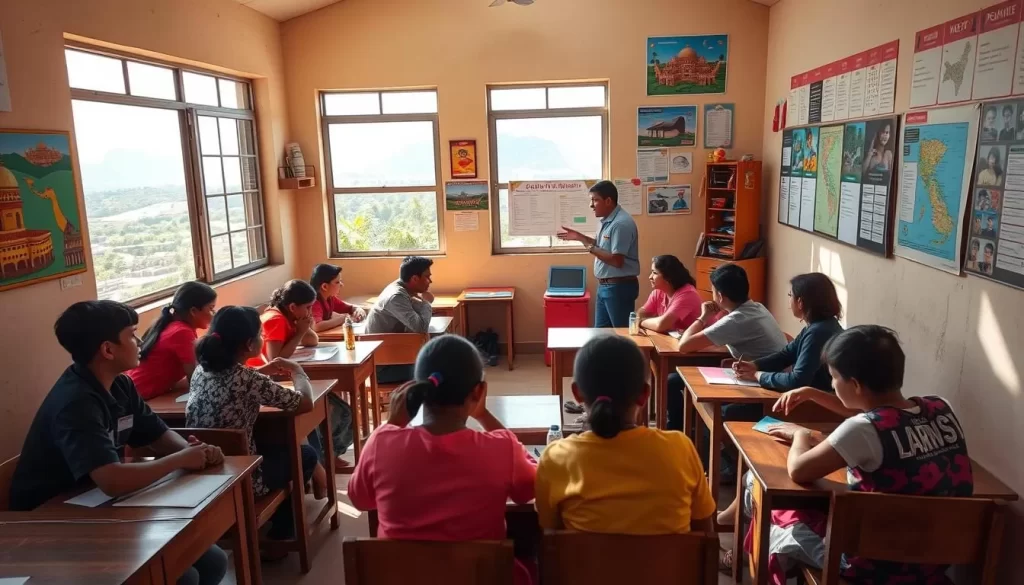
Odia Literature and Cultural Expression
You’ll find that Odia literature is a vibrant reflection of the region’s cultural identity, shaped by its history and traditions. The language has a rich literary heritage, with texts dating back to the 7th-9th centuries in the form of the Charyapadas, Buddhist mystical poems that represent some of the earliest specimens of Odia literature.
Classical Literary Traditions
The classical period of Odia literature began in earnest in the 14th century when Sarala Das, known as the “Vyasa of Odisha,” composed his monumental works, including the Odia Mahabharata, Chandi Purana, and Vilanka Ramayana. The Panchasakha poets of the 15th-16th centuries made significant contributions to Odia devotional literature. The medieval period saw the flourishing of the Riti Yuga, with poets like Upendra Bhanja developing elaborate poetic forms.
Modern Literature and Media
Modern Odia literature emerged in the late 19th century with the establishment of printing presses and the publication of the first Odia newspaper, Utkala Deepika, in 1866. The 20th century brought diverse literary movements, including romanticism, progressivism, and modernism, with writers gaining national and international recognition. Contemporary Odia literature continues to thrive through various forms, including novels, poetry, and drama, addressing both traditional themes and modern social issues.
Language Preservation Efforts
As you delve into the world of Odia, you’ll discover the concerted efforts to safeguard this classical language. The recognition of Odia as a classical language in 2014 marked a significant milestone, paving the way for various preservation initiatives.
Government Initiatives
The Odisha government has taken proactive steps to promote the Odia language. The establishment of the Odia Language Academy (Odia Bhasha Pratisthan) is a notable initiative, aimed at promoting research, documentation, and development of the language. The Odisha Official Language Act mandates the use of Odia in official communications, government documents, and signage, further solidifying its status.
The Department of Culture is also funding projects to digitize ancient Odia manuscripts, create comprehensive dictionaries, and develop standardized technical terminology in Odia for modern concepts. These efforts underscore the government’s commitment to preserving the language.
Community and NGO Efforts
Community-based organizations, such as the Odia Sahitya Akademi, play a vital role in promoting Odia through literary festivals, writing competitions, and cultural events. These activities not only celebrate the language but also encourage its use across different regions.
Non-governmental organizations are working at the grassroots level to revitalize endangered dialects and tribal languages. Their efforts include documentation projects, community language classes, and the production of learning materials. Additionally, innovative digital initiatives, such as Odia language apps and online dictionaries, are making the language more accessible to younger generations and the diaspora community.
Challenges Facing Minority Languages
As you explore the linguistic landscape of Odisha, you’ll discover that minority languages face significant challenges to their survival. Many tribal and regional languages are classified as vulnerable or endangered by linguistic experts.

Socioeconomic Factors
Socioeconomic factors play a crucial role in language shift, as speakers of minority languages often face limited economic opportunities unless they adopt dominant languages like Odia, Hindi, or English. Educational systems typically prioritize major languages, creating pressure on parents to choose dominant language education for their children to improve their future prospects.
The migration from rural to urban areas disrupts traditional language communities and accelerates language shift, as younger generations adapt to urban linguistic environments dominated by standard Odia and increasingly English.
Globalization and Language Shift
Globalization and digital media have intensified pressure on minority languages, with English and major Indian languages dominating online spaces, entertainment, and professional environments. The perceived low status of tribal and regional dialects compared to standardized languages contributes to declining intergenerational transmission as parents choose not to pass on their mother tongues.
Even as Odia itself receives protection and promotion as a classical and scheduled language, smaller languages within Odisha receive comparatively little institutional support, highlighting the tension between linguistic integration and diversity preservation.
Conclusion
Having examined the various languages spoken in Odisha, you’re now well-equipped to understand the importance of linguistic preservation. The state’s linguistic landscape is characterized by the dominance of Odia as the official language, with a rich history spanning over 1,500 years. As one of the classical languages of India, Odia has maintained its distinctiveness while adapting to changing cultural contexts.
The exploration of Odia’s dialectal diversity has revealed the significant role of geographical, historical, and cultural factors in shaping regional varieties like Kataki, Baleswari, Sambalpuri, and Ganjami. Each of these dialects has its unique characteristics, contributing to the rich tapestry of regional languages in Odisha. Moreover, the coexistence of Odia with numerous tribal languages belonging to Austroasiatic, Dravidian, and Indo-Aryan language families creates a complex multilingual reality.
Language education policies in Odisha strive to balance the promotion of Odia as the state language with the accommodation of linguistic diversity and the growing demand for English education. Preservation efforts by government agencies, communities, and NGOs are crucial in safeguarding both Odia and minority languages through documentation, education, and cultural initiatives.
The challenges facing minority languages in Odisha reflect broader global patterns of language endangerment due to socioeconomic pressures, urbanization, and globalization. As you reflect on Odisha’s linguistic heritage, you can appreciate how languages serve not just as communication tools but as repositories of cultural knowledge, identity, and worldviews that enrich human diversity.
The story of languages in Odisha continues to evolve, with ongoing efforts to balance preservation of linguistic heritage with the demands of modernization and global integration. As the official language of Odisha and the second official language of Jharkhand, Odia holds a significant status in the region. With approximately thirty-two million people speaking Odia as a first language, its importance cannot be overstated.
The above is subject to change.
Check back often to TRAVEL.COM for the latest travel tips and deals.


